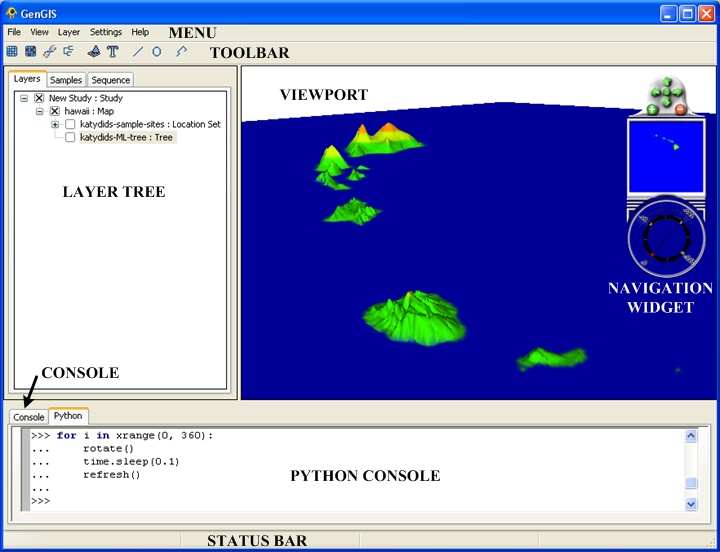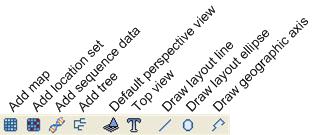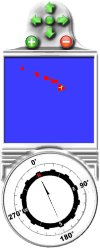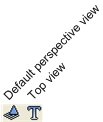Difference between revisions of "The GenGIS Manual"
| Line 153: | Line 153: | ||
== The Environment == | == The Environment == | ||
| − | The graphical user interface for GenGIS consists of a collection of different interface elements. Many features of GenGIS can be | + | The graphical user interface for GenGIS consists of a collection of different interface elements. Many features of GenGIS can be accessed through the ''Menu''. The most commonly used features are exposed on the ''Toolbar''. Data loaded into GenGIS is organized into a ''Layer Tree'', which is made explicit to the user in the panel on the left. This hierarchical structure provides a natural organization of data and allows the properties of related data items to be set easily. Data visualizations are displayed in the 3D ''Viewport''. Mouse navigation within this 3D environment follows a standard world-in-hand navigation model. Alternatively, the camera position and angle can be modified using the ''Navigation Widget'', which also provides an overview map. The ''Console'' provides feedback to the user such as the results of statistical tests and warnings about potential problems with loaded data. Almost all features available through the graphical user interface can be accessed within the ''Python Console'' window. This includes loading data layers, modifying camera parameters, and accessing location or sequence data. Information about interface elements or graphical features within the ''Viewport'' is displayed on the ''Statusbar''. |
[[Image:GUI_Overview_Mashup.jpg|frame|center|Overview of GenGIS graphical user interface.]] | [[Image:GUI_Overview_Mashup.jpg|frame|center|Overview of GenGIS graphical user interface.]] | ||
Revision as of 02:01, 5 May 2009
We continue to develop the manual.
A recent version of the manual will soon be available in Media:.PDF format.
Contents
- 1 Introduction / Overview of GenGIS
- 2 Installation
- 3 Input data
- 4 The Environment
- 5 Graphical analysis tools in GenGIS
- 6 The Python console and API functions
Introduction / Overview of GenGIS
Purpose
Geography has always been an important component of evolutionary and ecological theory. But the advent of sequence typing approaches such as 16S ribotyping, DNA barcoding using the COX1 gene, and multi-locus sequence typing, gives us the opportunity to understand how communities of organisms interact, move around and evolve. This sequencing revolution is tightly coupled to the development of new algorithms for assessing and comparing populations based on their genes.
Coupled with these developments is the ready availability of high quality, public domain digital map data. By integrating molecular data with cartography and habitat parameters, we can visualize the geographic and ecological factors that influence community composition and function.
GenGIS is designed to bring these components together into a single software package that satisfies the following criteria:
Free and open source. GenGIS is released under a Creative Commons Attribution - Share Alike 3.0 license, and we have made extensive use of other free packages such as wxWidgets, R, and Python. Making GenGIS freely available allows it to be downloaded and used anywhere in the world, and allows users to inspect and modify the source code.
User-friendly. Although GenGIS is built to deal with challenging scientific questions, our goal is to make the software as easy to use as possible. This is particularly important as many users will have little experience with digital map data, apart from applications such as Google Earth.
Adaptible and extensible. The principal strength of many open-source projects lies in the ability of a loosely organized community of users to develop and enhance the software: R and BioPerl are two examples of successful open-source projects with many contributors. Since the potential applications of GenGIS are much broader than those we have in mind, we aim to make it as easy as possible to extend its capabilities by exposing the internal data structures and offering a plugin architecture.
Platforms and System Requirements
GenGIS has been developed and tested on the following operating systems:
- Win32 (XP and Vista)
- Mac OSX 'Leopard'
Support for Linux is not a development priority at the moment. However, it should be fairly straightforward to port GenGIS to Linux and we will happily support any efforts to develop such a version. Similarly, let us know if you experience problems (or successes!) in trying to run GenGIS on an operating system not listed above.
GenGIS can have fairly demanding memory requirements, depending on the size of map that is loaded. We typically try to keep digital maps to a size of 10 MB or less. Please note that we have not tested GenGIS on Windows with anything less than a Pentium 4-class CPU, nor on anything older than a 2008-vintage iMac.
Citing GenGIS
The best citation for GenGIS will always be indicated in boldface on the [Main GenGIS page].
Where to go for help
The latest version of the GenGIS manual will always be available [here].
Tutorials are available [here].
We maintain a [FAQ] for GenGIS as well.
We may also at some point initiate a discussion forum.
Email beiko [at] cs.dal.ca if you have further questions about the software.
Installation
Getting the Release Version
If all you want to do is load in your data and start analyzing and visualizing them, your best bet is the latest Release version which is available [here].
Developer Version – building from source code
Building on Windows
GenGIS can be compiled using the Microsoft Visual C++ 2008 Express Edition solution file contained in win32/build/msvc. Please note that the Python console is only available for Release builds.
Building on Mac
GenGIS can be compiled using the Makefile contained in mac/build/gcc by typing 'make'. Development was done with gcc 4.3.3.
Input data
File dependencies
Currently there are four types of files that can be imported directly by the GenGIS application (i.e., not via the Python console or Rpy):
- The digital map file
- The location file
- The sequence file
- The phylogenetic tree file
Details of the requirements for these files are contained later in this section.
We currently require that you load the map file first, followed by the location file, after which any properly formatted set of 1 or more sequence and/or tree files can be loaded. To be considered in a visual or statistical analysis, every sequence in a sequence file, and every leaf in a phylogenetic tree, must be associated with one of the locations in the Location file.
Maps
Thanks to GDAL, GenGIS can import a wide array of digital map file formats and projections. We cannot provide direct support for GDAL, but there is a considerable amount of support available at the project website, and we have found the script 'gdal_merge.py' and the executables 'gdalwarp.exe' and 'gdal_translate.exe' to be very useful in preparing maps that can be handled by GenGIS.
Supported formats
GenGIS should be able to support any of the formats listed on this page due to the use of GDAL as our data reader, but many of these remain untested. We have had success with the following widely used formats:
- GeoTIFF
- Arc/Info ASCIIGRID
- USGS DEM (and variations thereof)
Projections
If you wish to use a specific projection, you must specify it before loading your map - GenGIS is unable to do reprojections on the fly. This is particularly true if you are loading the default world map (from GTOPO30) that ships with GenGIS: the default Mercator projection stretches the polar regions to an absurd degree, whereas Plate Carre or Robinson will provide a much less distorted world view.
GenGIS currently does not support projections in which a single point is displayed in multiple locations. The best example of this is the default world map, which is actually 'fudged' to stretch only from 89.9 degrees North to 89.9 degrees South latitude. Since the poles stretch across the entire upper and lower edges of a map in a projection such as Plate Carre, GenGIS is unable to display these properly.
To specify the projection before loading your map, right click "New Study : Study" in the Layers tab, and select Properties. Selecting the Projection tab will allow you to choose your projection.
IMAGE SS1-MapProj.jpg (to upload)
Typical limits on map size
The size of map you can load and usefully work with in GenGIS is proportional to the speed of your processor and amount of RAM you have. With 1 GB of RAM you should be able to work with maps that are 10 MB or slightly greater in size.
If the resolution of your map is too high to load efficiently into GenGIS, you can use one of the GDAL executables (gdalwarp or gdal_translate) to reduce the density of points in your map. This will of course decrease the level of detail you can see in the application, but is an acceptable tradeoff in many cases.
Location File
The location file must be provided in a comma-separated format (e.g., the .csv files that can be exported from Microsoft Excel). The first line of the file must be a comma-separated series of headers. Each subsequent line will contain a set of attributes for a single location.
The first three entries on each line must be:
- A unique location identifier
- A vertical coordinate, either decimal degrees of latitude or Universal Transverse Mercator (UTM) northing. Note that positive values = north and negative values = south.
- A horizontal coordinate, either decimal degrees of longitude or UTM easting. Positive values = east and negative values = west.
The first line of the file must therefore begin with the following three column headings:
Site ID,Latitude,Longitude
or
Site ID,Northing,Easting
depending on the coordinate system.
After these three columns, you can specify anything you like in the Location file, including longer descriptive site names, environmental parameters, and a time stamp. So, for instance, a location file header might look like this:
Site ID,Latitude,Longitude,File Size,Environment Type,Geographic Location,Site Name,Country
Each of these values must then be specified for every entity (= row in the file), even if they are called NULL or some other placeholder value.
Sequence File
The basic specification of the sequence file is even simpler, with only two required field:
- A unique location identifier that is also found in the location file
- A unique sequence identifier
The first line of the file must begin with the following column headings:
Site ID, Sequence ID
As with the location file, after these essential columns any type of information can be provided. Note that the 'sequence file' need not contain any molecular sequence data, nor do the entities necessarily need to have a one-to-one correspondence to actual sampled sequences.
A simple sequence file might summarize the taxonomic classification of each sampled sequence:
Site ID,Sequence ID,Best_match,Species,Genus,Family,Order,Class,Phylum,Superkingdom
As with the location file, each row of the sequence file must define a value for each of the columns identified in the header line.
Phylogenetic trees
Input phylogenetic trees should adhere to the Newick file format, with the additional constraint that leaf labels must match up exactly with either a Site ID from the location file or a Sequence ID from the sequence file.
The Environment
The graphical user interface for GenGIS consists of a collection of different interface elements. Many features of GenGIS can be accessed through the Menu. The most commonly used features are exposed on the Toolbar. Data loaded into GenGIS is organized into a Layer Tree, which is made explicit to the user in the panel on the left. This hierarchical structure provides a natural organization of data and allows the properties of related data items to be set easily. Data visualizations are displayed in the 3D Viewport. Mouse navigation within this 3D environment follows a standard world-in-hand navigation model. Alternatively, the camera position and angle can be modified using the Navigation Widget, which also provides an overview map. The Console provides feedback to the user such as the results of statistical tests and warnings about potential problems with loaded data. Almost all features available through the graphical user interface can be accessed within the Python Console window. This includes loading data layers, modifying camera parameters, and accessing location or sequence data. Information about interface elements or graphical features within the Viewport is displayed on the Statusbar.
Menu Items
File Menu
- New study: (In development) Creates a new study. A study can contain any number of maps, location sets, sequence data files, and geographic tree models.
- Open study: (In development) Open a previously saved study.
- Save study: (In development) Save the current study.
- Save study as: (In development) Save the current study under a new filename.
- Save image as: (In development) Save Viewport contents to a PNG file.
- Exit: Exits the program.
View Menu
- Panes->Side Panel: Hide/unhide the left side panel containing the Layer tree.
- Panes->Console: Hide/unhide the bottom panel containing the Console and Python Console.
- Camera Position->Default: Move camera to its default perspective position.
- Camera Position->Top: Move camera to give a top-down view of the map.
- Detail->Fine: Increase the level-of-detail of the map.
- Detail->Coarse: Decrease the level-of-detail of the map.
Layer Menu
- Add map: Add a map to the currently selected study.
- Add location set: Add a location set to the currently selected map.
- Add sequence data: Add sequence data to the currently selected location set
- Add tree: Add a geographic tree model to the currently selected map.
- Remove layer: Remove the currently selected layer.
- Hide all layers: Hide all layers so they are no longer displayed in the Viewport.
- Show all layers: Show all layers in the Viewport.
Settings Menu
- Lighting: Brings up the Lighting Properties dialog box which allows properties of the light source used to render the Viewport to be modified.
- Layout objects: Brings up the Layout Objects Properties dialog box which all visual properties of layout primatives to be modified.
Help Menu
- About: Brings up an About GenGIS dialog box which contains a link to this website in addition to other information.
Toolbar Buttons
The Toolbar provides easy access to frequently used features.
- Add map: Add a map to the currently selected study.
- Add location set: Add a location set to the currently selected map.
- Add sequence data: Add sequence data to the currently selected location set
- Add tree: Add a geographic tree model to the currently selected map.
- Default perspective view: Move camera to its default perspective position.
- Top view: Move camera to give a top-down view of the map.
- Draw layout line: Draw a straight line which can be used to layout graphic elements such as a 2D tree or pie charts.
- Draw layout ellipse: Draw an ellipse which can be used to layout graphic elements such as a 2D tree or pie charts.
- Draw geographic axis: Draw a polyline which can be used to test the goodness-of-fit between a tree and a non-linear geographic axes (see 2D Pylogenetic Trees).
Mouse
You can move the map by holding down the left mouse button while moving the mouse. To change the pitch of the camera, hold the right mouse button down and move the mouse up and down. Similarly, to rotate the map move the mouse left or right while holding down the right mouse button. The camera can be zoomed using the scroll wheel on your mouse.
The navigation widget can also be used to navigate around the map. The arrows at the top of the widget allow the map to be moved while the plus and minus button let one zoom in and out of the map. Clicking on the compass and dragging the mouse around the compass face allows one to rotate the map. User can jump to a specific point in the map by clicking within the overview map.
Predefined Views
GenGIS also provides two convenient default views. To quickly switch to a perspective view or a top down view use either the View→Camera Position menu items or the corresponding toolbar buttons.



